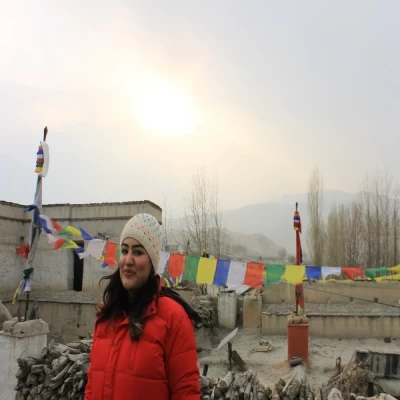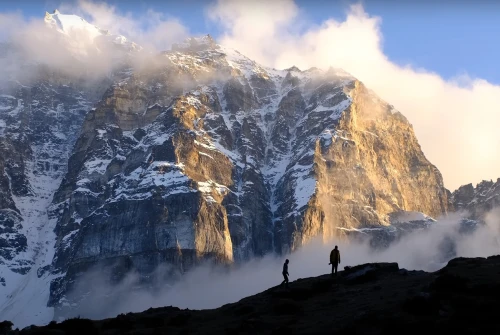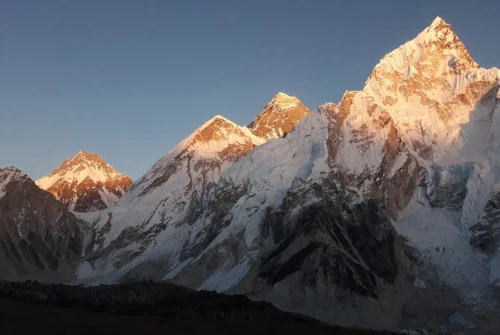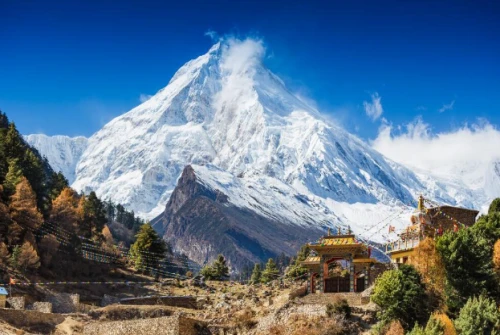Moreover, the dramatic transition in landscape from subtropical forests to alpine highlands makes each day on the trail feel like a brand-new adventure. You'll ascend through deep river gorges, walk under waterfalls, and eventually rise above the clouds to cross the formidable Larke Pass at 5,160 meters. That sense of progression, both in terrain and culture, is something few treks in Nepal can match.
Detailed Cost Breakdown of Each Permit
Cost of RAP (Based on Seasons and Days)
The most crucial permit you’ll need for the Manaslu Circuit is the Manaslu Restricted Area Permit (RAP). This isn’t just a formality, it’s a legal requirement issued by the Government of Nepal to protect the sensitive regions along the trail. The restricted area starts from Jagat and continues until you reach Sama Gaon.
During the peak trekking months of September, October, and November, the RAP costs USD 100 for the first 7 days, then USD 15 per additional day. Let’s say you spend 10 days in the restricted zone. That means you’ll pay $100 + (3 x $15) = $145 total. During the off-season months, December through August, the rate drops to $75 for the first 7 days and $10 per day afterward, which is a good deal if you're willing to brave the colder months or the monsoon.
Now, here’s where many trekkers stumble: you can’t just pay for 7 days and extend later. The entire permit must be obtained before you start trekking, based on your expected travel schedule. If you're delayed or want to stay longer in villages like Samdo or Samagaun, which are stunning acclimatization points, you'll need to account for that upfront.
To summarize:
Month | First 7 Days Cost | Additional Per Day | Example (10 Days) |
Sept–Nov | $100 | $15/day | $145 |
Dec–Aug | $75 | $10/day | $105 |
For a 10-day permit, expect to budget between $105 to $145, depending on the season. This is non-negotiable, non-refundable, and you must go through a trekking agency to get it.
Cost of MCAP and ACAP
A Manaslu Conservation Area Permit (MCAP) is needed to enter the conservation area that surrounds the Manaslu region. Issued by the Nepal Trust for Nature Conservation (NTNC), this permit supports environmental preservation and local community development.
The cost of the MCAP is fixed at NPR 3,000 (approximately USD 25) for a foreign nation. SAARC nationals receive a discounted rate of NPR 1,000. There are no requirements to hire a guide or join a group for this permit specifically, but since you’ll already need to meet these for the RAP, the difference is negligible.
While the RAP takes the spotlight, don’t forget about the MCAP (Manaslu Conservation Area Permit) and the ACAP (Annapurna Conservation Area Permit). These two are essential if you’re doing the full circuit trek, which ends by merging into the Annapurna region after crossing the Larke La Pass.
Each of these costs NPR 3,000, which is around USD 25. They are flat-rate permits, unaffected by the number of days you spend in the area or the time of year you trek. That makes budgeting a bit simpler for this part.
Let’s break it down:
Permit Type | Cost (in NPR) | Cost (USD Approx) | Required For |
MCAP | 3,000 | $25 | Entry from Soti Khola |
ACAP | 3,000 | $25 | Trek to Dharapani |
Unlike the RAP, you can technically get MCAP and ACAP individually at the Nepal Tourism Board offices in Kathmandu or Pokhara. But since you’ll already be booking through a trekking agency for the RAP, they’ll likely process all three permits together to save you the hassle.
Total cost for MCAP + ACAP = USD 50
Additional Trekking Requirements
Need for a Registered Guide and Group Trekking
Currently, it’s mandatory to hire a licensed guide for the Manaslu Circuit trek. There’s no workaround here. Unlike the Annapurna or Langtang regions, where you can still trek solo, Manaslu falls under Nepal’s Restricted Area Policy, and you can’t even apply for permits without a guide and an official trekking agency.
Moreover, you must trek in a minimum group of two (excluding the guide). Many agencies help solo trekkers by pairing them with others who have flexible travel dates. This not only fulfills legal requirements but also makes the experience more enjoyable and affordable.
Let’s talk numbers. A registered guide typically charges $25 to $35 per day, which includes their food, accommodation, and insurance. For a 14-day trek, you’re looking at around $350 to $490 for guiding services.
What does a guide do besides leading the way? A lot. They handle permit checks, language barriers, logistics, and most importantly, they ensure your safety, especially in high-altitude zones like the Larke Pass. Good guides are also walking encyclopedias explaining local customs, translating conversations, and recommending the best teahouses and dishes.
Pro Tip: Always verify your guide’s license and whether they have first-aid training. Some agencies also provide female guides upon request for solo female travelers.
Budgeting the Entire Trek
Transportation Costs to and from the Trailhead
One often underestimated component of your Manaslu Circuit budget is transportation. Since there are no airports near the trailhead, you’ll be taking a combination of private jeeps or public buses to reach Soti Khola or Machha Khola, the common starting points for the trek.
If you’re going by public bus, the journey from Kathmandu to Soti Khola takes 8 to 10 hours and costs around NPR 800–1,200 ($6–$10). Buses are cheap but notoriously slow, uncomfortable, and sometimes unreliable due to weather or strikes.
For more comfort, most trekkers hire a shared or private jeep, which shortens the journey and offers flexibility. A shared jeep costs around $30–$35 per person, while a private jeep costs around $160–$200 one way. If you’re in a group, this becomes more affordable and far more comfortable than crammed local buses.
On the way back, you’ll usually end the trek at Dharapani or Besi Sahar, which connects to the Annapurna Circuit. From Dharapani, you’ll need a jeep to Besi Sahar ($20–$25) and then a bus to Kathmandu ($8–$15).
Estimated Round Trip Transportation Budget:
Budget Option (Public Bus): $15–$20
Comfortable Option (Jeep + Bus): $60–$100
Private Jeep Both Ways: $350+ (Split among trekkers)
Don’t forget to include tips for your driver and emergency funds in case of roadblocks or rerouting, which are common in rural Nepal due to landslides.
Accommodation and Food Expenses
Accommodation on the Manaslu Circuit is basic but cozy, with teahouses dotting almost every village along the route. These are family-run lodges providing a bed, meals, and a friendly smile. Expect to pay $5–$7 per night for a twin-sharing room, though many teahouses offer free lodging if you eat dinner and breakfast there.
Rooms are very simple, usually just two beds, a foam mattress, blankets, and maybe a lightbulb. Toilets are mostly shared and squat-style, with cold water unless you pay extra for a bucket of hot water.
Food costs, however, add up quickly. The higher you go, the more expensive everything becomes due to the lack of road access. A plate of dal bhat (rice, lentils, vegetables, and curry) costs $3–$4 at lower elevations, climbing to $7–$8 at higher villages like Samdo or Dharmasala. Instant noodles, Tibetan bread, pasta, momos, and fried rice are also commonly available.
Sample Daily Food Budget:
Breakfast (pancakes, tea): $4–$6
Lunch (dal bhat): $5–$7
Dinner (noodles + tea): $6–$9
Total Daily Food Cost: $15–$25
Total for 14-Day Trek: $210–$350
Also, budget for extras like:
Hot shower: $2–$5
Wi-Fi (if available): $2–$5
Charging phones/power banks: $1–$3 per hour
So for a full 2-week trek, expect to spend $300–$400 on food, lodging, and small luxuries if you’re mid-range budget-conscious. Ultra-budget trekkers can shave this down, but you'll miss out on some comforts.
Miscellaneous Costs (Wi-Fi, Hot Showers, Tips)
Even in the Himalayas, small expenses add up fast, especially when it comes to basic “luxuries” like staying clean, connected, and well-charged. While these may seem minor on their own, they can significantly affect your budget by the end of your trek.
Hot Showers
These aren’t included with your room. Expect to pay $2–$5 for a bucket of hot water or a gas-heated shower. As you go higher, the cost rises. Most trekkers take 3–4 showers during a 14-day trek, adding up to $15–$20.
Wi-Fi and SIM Cards
Wi-Fi isn’t available everywhere, and when it is, it usually costs $2–$5 per hour. Some villages offer a “Wi-Fi Card” that you scratch off to use the internet on your phone. Alternatively, get a Nepal Telecom 4G SIM in Kathmandu and buy a data package (~$10 for 5GB). It works until you go above 3,000m, after which connectivity becomes spotty.
Charging Electronics
Charging isn’t free, especially higher up. Teahouses charge $1–$3 per hour for charging phones, cameras, or power banks. Some places may limit access if the power source is solar-based.
Tips and Donations
It’s customary (and appreciated) to tip:
Guide: $100–$150 (depending on service quality)
Porter: $60–$100
Teahouse staff: small change ($1–$2) if they go above and beyond
Other Miscellaneous Costs:
Toilet paper (not provided): $1–$2 per roll
Snacks (chocolates, energy bars): $1–$3 each
Extra clothes, gear rental in Kathmandu: $10–$50
Total estimated miscellaneous costs: $100–$200, depending on how comfortable you want your trek to be.
Seasonal Considerations and Their Impact on Cost
Peak vs Off-Peak Season Pricing
Trekking Manaslu during peak season (Sept–Nov and Mar–May) is beautiful, but it also comes with higher costs across the board. This is when the views are clearest, and the weather is stable, attracting the most trekkers.
During this time:
RAP permit costs more ($100 vs $75)
Teahouses may raise prices due to demand
Guides and porters are in high demand, and prices may surge by 10–20%
Transport costs rise, as jeeps are booked quickly
By contrast, trekking in the off-season (Dec–Feb and Jun–Aug) can help you save $100–$150, but comes with trade-offs:
Heavy snow or monsoon rains can make trails dangerous
Fewer open teahouses and limited facilities
Shorter daylight hours, especially in winter
Larke Pass may be impassable due to snow
Still, for experienced trekkers or those on tight budgets, the off-season can offer lower prices and greater solitude. Just make sure to check weather forecasts and consult with your trekking agency to adjust your itinerary based on trail conditions.
Weather Effects on Logistics and Budgeting
Weather doesn’t just affect your mood, it changes everything from your daily schedule to emergency costs. During monsoon season, landslides may block roads to Soti Khola, forcing you to reroute, delay, or even hire helicopters in rare cases.
In winter, deep snow may prevent crossing the Larke La Pass, forcing trekkers to turn back early, potentially wasting permit days. Emergency evacuation due to altitude sickness or injuries can be costly, with helicopter evacuation costs ranging from $3,000 to $5,000. This is why travel insurance is essential.
Unexpected budget hits due to weather:
Extra days on the trail: $25–$30/day
Delays in transportation: $20–$50
Emergency gear purchase: $20–$100
Rescue costs (if uninsured): $3,000+
It’s wise to have an emergency buffer of $200–$300, just in case. If you don’t need it, great, you’ll have extra cash to splurge in Kathmandu post-trek.
Tips for Saving Money on the Trek
Group Discounts
Trekking with a group can significantly lower your per-person cost, especially for:
Guide and porter sharing
Private jeep transportation
Permit processing fees
Most agencies offer discounts for groups of 3 or more. You can also join a fixed departure group if you're solo but flexible with dates.
Savings estimate: $100–$200 per person in a group of 3+
Choosing Budget vs Luxury Treks
Luxury treks offer upgraded lodges, private rooms, fancy meals, and even portable oxygen—but at a premium. Budget treks are more “authentic” and rely on basic teahouse accommodation and local food.
If you’re okay with bucket showers, shared toilets, and local dal bhat, you can easily trek Manaslu on $35–$45/day, excluding permits.
Savings estimate: $300–$500 compared to luxury options.
Packing Smart to Avoid Rental Fees
Packing right can save you a ton. Avoid renting by bringing essentials like:
Sleeping bag (rated -10°C or lower)
Down jacket
Trekking poles
Headlamp, power bank, toiletries
Rental gear may cost $1–$3 per item/day, adding up to $50–$100 over 2 weeks. If you bring your own, you save and ensure quality.
Important Things to Know Before You Go
Rules and Regulations in Restricted Areas
In restricted zones like Manaslu, the government enforces strict trekking rules:
No solo trekking: You must have a guide and a group.
No camping in unauthorized areas
Respect local customs: No loud music, drone usage, or inappropriate clothing
Permit checks are frequent—carry originals and copies
No off-route detours: Stay on approved trails
Violating these rules can result in fines, permit revocation, or even deportation. So play by the book.
Safety and Health Considerations
The Manaslu Circuit rises above 5,000 meters, so altitude sickness is real. Acclimatize properly, drink lots of fluids, and carry Diamox (with medical advice). Guides are trained to detect symptoms like headache, dizziness, and nausea, and take action.
Also:
Boil or purify all drinking water.
Watch out for yak trains on narrow paths.
Carry a basic medical kit: band-aids, antiseptics, painkillers, etc.
Environmental Concerns and Responsible Trekking
You’re walking through pristine terrain, so leave no trace:
Carry trash out
Avoid using plastic bottles; use water purifiers
Stay in community-run lodges to support locals
Don’t disturb wildlife or pick plants
Manaslu is special because it’s untouched. Let’s keep it that way.
Conclusion
Trekking the Manaslu Circuit is more than just an adventure, it’s a deep dive into one of the most unspoiled, culturally rich regions of Nepal. With its majestic mountains, Tibetan-inspired villages, and remote trails, it offers a truly off-the-beaten-path experience. But to enjoy it fully, you must plan properly, especially when it comes to permits and costs.
From the mandatory Restricted Area Permit to the logistics of transportation, accommodation, and guide services, everything must be aligned with official regulations and your comfort. Yes, the trek is a bit more complex (and pricier) than others, but the reward is an unmatched experience of Himalayan wilderness and cultural depth. With proper planning, we at All Nepal Hiking guarantee an adventurous spirit.
Manaslu is not just a trek, it’s a life-changing journey waiting to happen. So, hurry up and book your trek with us.




